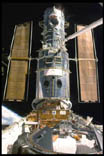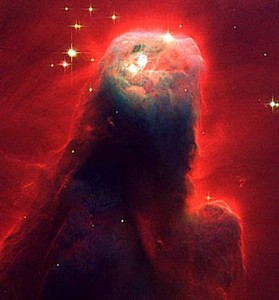
The Hubble Space Telescope (HST) is a reflector telescope that orbits the Earth every 96 minutes. This “eye in the sky” moves in an orbit that is about 600 km (375 miles) above Earth. The reason that this telescope is so much better than telescopes on Earth, is that the atmosphere above it is very thin. On earth, light from stars and other celestial bodies must travel through miles of atmosphere before reaching a telescope. Stuff in the atmosphere, including atmospheric gases, cause images of stellar objects to be less clear than the same object viewed by Hubble.

Hubble was launched on April 25, 1990. This was no small task because of its size and weight. The tube part is about This “Eye in the Sky” is very big – about the size of a large school bus. The tube-like part of Hubble’s body is about 4.3 (14 feet) meters across, and the telescopes stands about 13 meters (43 feet) tall. It weighs over 25,000 pounds, but in space its weight is almost zero. FYI: I say almost zero because weight is a measure of gravity and even in space there is some gravity.
The space shuttle Discovery carried Hubble into orbit, the telescope completely filled Discovery’s cargo bay.
On August 11, 2008, the Hubble Space Telescope completed its 100,000th orbit.
The photo shown was taken by Hubble and is called the Cone Nebula. A nebula is a space cloud made mostly of hydrogen gas and dust. The part shown is about 2.5 light- years in length. This is one of many photos taken by Hubble of stellar objects. The farthest objects Hubble has seen are galaxies well over 12 billion light-years away.
SPACE DISTANCE for information about measuring distances in light-years.https://scienceprojectideasforkids.com/?s=space+distance
For more information about astronomy, see Janice VanCleave’s Astronomy for Every Kid
(Paid Link)
